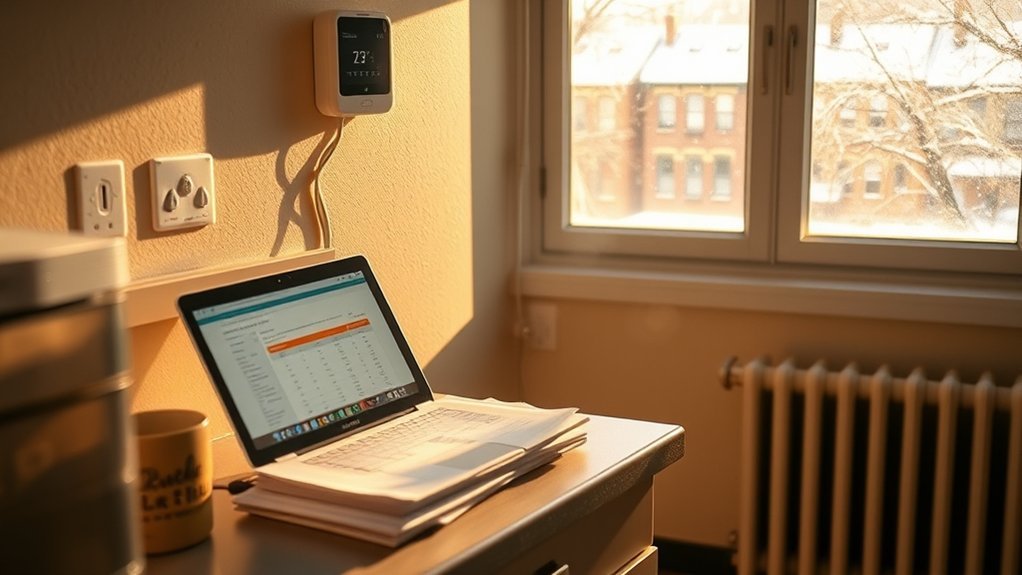If you’re planning life in Pittsburgh, you’ll want a realistic monthly budget and a clear sense of what essentials cost. Housing is surprisingly affordable—one-bedrooms often near $960—but utilities, groceries, and transport add up, pushing a practical single-person budget toward the mid-$4,000s. I’ll break down rent, bills, transit, healthcare, and neighborhood differences so you can see what to expect and which choices shave costs.
Cost of Living Snapshot: Pittsburgh vs. State and U.S

Often, you’ll find Pittsburgh comes in cheaper than many expect: its overall price level, measured by BEA Regional Price Parities, is 94.4 for 2023—about 5.6% below the U.S. averageBEA RPP (published 2024-12-12). Housing still drives the advantage: the average rent across unit types runs about $1,530Zillow Rent Trends (viewed 2025-10), while recent city medians are about $1,385 for a one-bed and $1,641 for a two-bedApartments.com (2025-10). On the buy side, the typical home value in the city is roughly $240,402 (Sep 2025) versus Pennsylvania $281,369 and the U.S. $363,946Zillow Pittsburgh (accessed 2025-10)Zillow Research: U.S. Typical Value (viewed 2025-10). State tax remains a flat 3.07%; Allegheny County’s combined sales tax totals 7% (6% state + 1% county add-on)PA Dept. of Revenue (viewed 2025-10).
You’ll see the cost of living advantage mostly in housing costs: median rent and home prices tilt Pittsburgh vs U.S. in your favor.
Compare that to median household income and a realistic monthly budget to judge affordability.
Monthly Budget Breakdown for Single Residents and Families

You’ll typically need about $4,554/month as a single resident to cover housing, food, utilities, transportation and other essentials. Plan $960–$1,200+ for rent depending on unit size and neighborhood, plus roughly $227/month for utilities (915-sq-ft) and $70 for internetApartment List guide (updated 2025-10-09), noting actual bills vary by building and season. For families, monthly totals jump—examples include about $7,639/month for a married couple with young children and grocery costs near $13,335/year for a family of four—so expect substantially higher combined housing and living expenses. Additionally, initial startup costs for group homes may significantly impact local housing markets and availability.
Single Resident Essentials
To get a realistic monthly budget for a single resident in Pittsburgh, break expenses down by categories and plug in current local averages so you can plan precisely. Use the 30% rule to target income if you want rent in Pittsburgh around a median one bedroom apartment at $960. Your monthly budget will include rent, utilities (~$226.90), internet (~$69.58), groceries (~$378–$379), and healthcare (~$268). Transportation costs vary: car owners average ~$965/month for a new vehicle, all-in (AAA 2025), while Pittsburgh Regional Transit (PRT) fares are $2.50 with ConnectCard/PRT Go or $2.75 cash; 10-trip is $25 and a 31-day pass is $97.50AAA Your Driving Costs 2025 (2025-09-16)PRT Fares (viewed 2025-10).
| Category | Typical Monthly | Notes |
|---|---|---|
| Housing | $960 | one bedroom apartment median |
| Utilities+Internet | $296.48 | avg utilities + internet |
| Food & Transport | $1,172–$1,173 | groceries + car/transit options |
Family Monthly Totals
Comparing family budgets in Pittsburgh shows how quickly costs scale compared with single-resident spending: a typical married couple with young children spends about $7,639/month (housing $2,086, groceries $1,318, utilities $969).
You should plan for higher monthly expenses when moving from single to family of four budgeting — groceries and childcare drive most of the increase.
Data show homeowners face larger goods & services bills and utilities, pushing totals above $8,000 for families with older children.
Use the renter household baseline ($4,854) and the per-resident average ($4,554) to gauge needs and spot gaps.
Track housing costs, groceries, utilities, and childcare separately, then add savings and healthcare lines to arrive at realistic monthly expenses for your family.
Housing and Utilities
While housing remains the single largest line in your budget, total monthly costs often exceed base rent once utilities, internet, parking and seasonal heating are included. Expect the median one-bedroom rent in Pittsburgh (~$960) to be a starting point, not the full monthly budget. Typical renter housing-related expenses run $1,383–$1,780 depending on neighborhood—Shadyside averages about $1,540 for rent alone.
Utilities for a ~915 sq ft apartment average $226.90/month and internet (60+ Mbps) is about $69.58/monthApartment List guide (updated 2025-10-09). Parking or building fees add more. Follow the 30% rent guideline and request past utility bills and primary heating info before signing.
Rent Trends and Neighborhood Price Guide

Rent in Pittsburgh varies by neighborhood and unit size. As of October 2025, city medians are approximately $1,385 for a one-bedroom and $1,641 for a two-bedroomApartments.com (2025-10). Pockets like Shadyside currently show a ~$1,488 1-bed medianZumper, Shadyside median (2025-10-11), while the average rent (all units) citywide is close to $1,530Zillow Rent Trends (viewed 2025-10).
You should use the median one-bedroom rent as a baseline when comparing neighborhood rent differences and Pittsburgh rent trends. Apply the 30% rent guideline: a $960 rent implies about $38,400 annual gross income. Expect additional rental costs — monthly utilities and fees (Wi-Fi, parking, heat) commonly add $100–$300+. Also budget one-time move-in fees like application, security, and pet deposits. Below is a simple neighborhood snapshot to help you compare typical rents and likely extras. Additionally, understanding replacement costs can help you plan your budget more effectively.
| Neighborhood | Typical Rent |
|---|---|
| Shadyside | $1,488 (1-bed median)Zumper 2025-10-11 |
| City medians | $1,385 (1-bed) / $1,641 (2-bed)Apartments.com 2025-10 |
| Average (all units) | $1,530Zillow 2025-10 |
Buying a Home: Median Prices and Affordability

You’ll notice Pittsburgh’s typical home value sits near $240,402 (Sep 2025)—below Pennsylvania’s $281,369 and the U.S. $363,946Zillow Pittsburgh (accessed 2025-10)Zillow Research: U.S./PA values (viewed 2025-10). With 30-year mortgage rates ~6.30% in the latest weekly survey, monthly payments are higher than in low-rate erasReuters (citing Freddie Mac PMMS, 2025-10-09). Also factor in the City of Pittsburgh’s 5% realty transfer tax (vs. ~2% in many suburbs)Allegheny County: Realty Transfer Taxes (viewed 2025-10) plus utilities and local tax differences when comparing rent-vs-buy.
Median Home Price Comparison
Although Pittsburgh’s values sit below state and national figures, actual prices vary widely by source and neighborhood. Use the city’s typical home value as a starting point and check active listings. That variation affects ownership costs beyond purchase price — closing fees, local realty transfer tax (5% in the city), property taxes and insurance. With current rates (~6.30%), your mortgage payment on a Pittsburgh median-priced house will generally be lower than national equivalents; always model mortgage + taxes + utilities versus local rent before committingTransfer taxFreddie Mac PMMS via Reuters 2025-10-09.
Buying Vs Renting Affordability
Because Pittsburgh’s typical home value is well below the U.S. median, buying can look attractive on paper, but you should run the numbers for your situation. Compare payments on a Pittsburgh-priced home with city rents. Using a 30% rule, a $960 rent implies roughly $38,400 income, while median household income is about $64,137DataUSA (ACS 2023), so many households could qualify to buy.
Utilities, Internet, and Seasonal Energy Costs

Factoring in utilities, internet, and seasonal energy costs will change your monthly budget substantially in Pittsburgh: average utilities for a 915-sq.-ft. apartment run about $226.90/month, and internet (60+ Mbps) averages $69.58/monthApartment List guide (updated 2025-10-09).
Factoring utilities, internet, and seasonal energy, monthly Pittsburgh housing costs can range widely based on building, heating type, and household size.
Combined phone/telecom examples near $200/month can push your monthly utilities higher. Plan ahead by asking for recent utility statements before you sign.
Transportation Costs: Driving, Public Transit, and Commuting

When you plan your monthly budget for getting around Pittsburgh, expect transportation to be a major line item: owning and driving a new vehicle averages about $11,577 per year (roughly $964.78/month) in 2025AAA Your Driving Costs (2025-09-16). Pennsylvania’s average gasoline price recently hovered near $3.28/galAAA Gas Prices PA (2025-10-09). If you use public transit, Pittsburgh Regional Transit (PRT) charges $2.50 with ConnectCard/PRT Go or $2.75 cash; a 10-ride is $25 and a 31-day pass runs $97.50PRT Fares (viewed 2025-10).
Groceries, Dining Out, and Local Food Prices

Stretch your grocery dollars in Pittsburgh: overall food costs run about 2% below the national average, so a single adult can expect roughly $378/month (~$4,537/year) and a family of four about $13,335/year. You’ll find common groceries like a gallon of milk ~$4.25, bread ~$3.70, a dozen eggs ~$3.27, and ground beef ~$6.88. Grocery staples vary — steak ~$15.50, frozen meal ~$3.22, lettuce ~$1.88 — so shop sales and neighborhood stores to trim your monthly food budget.
Dining out stays reasonable: inexpensive meals average $15–$20, while a mid-range three-course dinner for two runs about $60–$62.50. Coffee prices (~$5.15) and small extras push miscellaneous spending higher, so factor those into week-to-week plans. Use a mix of bulk buys, occasional dining out, and targeted coffee treats to keep food prices predictable and your overall food spending within your budget. Additionally, understanding repair costs for items like school computers can help in budgeting for unexpected expenses.
Healthcare, Insurance, and Other Essential Services

Usually, healthcare in Pittsburgh runs slightly below the national average, but you’ll still want to budget carefully: a single adult can expect roughly $3,219 annually (~$268/month) and a family of four about $9,360/year (~$780/month). You’ll face routine costs: primary care visits ~$96–$99, dental $124–$129, and optometry ~$105. Prescription prices run ~33% higher than the U.S. average ($27.56 vs $20.78), so factor that into your monthly plan.
| Service | Typical Cost | Note |
|---|---|---|
| Primary care | $96–$99 | per visit |
| Dental | $124–$129 | routine exam |
| Prescription | $27.56 avg | per fill, higher locally |
| Insurance/out-of-pocket | varies | check plan formularies |
Compare health insurance premiums and networks from local providers (UPMC, Allegheny, Highmark). That will lower unexpected out-of-pocket expenses. Review provider lists and formularies before enrolling so healthcare costs stay predictable.
Job Market, Income Targets, and Tax Considerations

Healthcare costs affect how much you need to earn, but income, taxes, and the job market ultimately determine whether you can comfortably cover those bills.
You’ll judge affordability by targets: the December 2024 median rent for a one-bedroom is $960, so following the 30% rent rule implies about $38,400 gross annually (≈$18.46/hr). Comfortable single-adult targets are closer to $58,248, while MIT’s living wage puts a single adult above $47,338 and a single parent with one child near $85,000MIT Living Wage (viewed 2025-10).
Pittsburgh’s median household income is about $64,137, with an unemployment rate near 3.9% (Aug 2025); major employers are in healthcare, education, and techDataUSA (ACS 2023)PA DLI Press Release (2025-09-30).
Factor taxes: Pennsylvania’s state income tax is 3.07% plus Pittsburgh’s resident Earned Income Tax totals 3% (1% City + 2% School District) and Allegheny County sales tax totals 7.00%City of Pittsburgh — EIT (viewed 2025-10)PA Dept. of Revenue (viewed 2025-10).
Frequently Asked Questions
How Much Does It Cost per Month to Live in Pittsburgh?
You’ll typically spend about $3,800–$4,600 monthly in Pittsburgh, covering rent, utilities, food, transport, and healthcare; a comfortable single-adult budget targets roughly $4,800–$4,850/month, depending on neighborhood and lifestyle.
How Much Money Do You Need to Live Comfortably in Pittsburgh?
You’ll need about $58,248 per year before taxes (roughly $4,854/month) to live comfortably in Pittsburgh; that covers median rent, groceries, utilities, transport, healthcare, and modest savings for a single adult.
Is Pittsburgh Affordable Rent?
You might think pricey neighborhoods ruin affordability, but Pittsburgh is generally affordable: you’ll find median one-bedroom rent around $960, implying about $38,400 annual income needed, though some areas cost much more—factor utilities and transport.
What Is the Cost of Living Index in Pittsburgh?
Pittsburgh’s price level (BEA RPP) is about 94.4 (U.S. = 100) for 2023, so you’ll find it roughly 5.6% cheaper than the national averageBEA RPP (published 2024-12-12).
Conclusion
Think of Pittsburgh’s cost of living as a three-bedroom rowhouse: one room for low rent (about $960), another for predictable essentials (utilities ~$227, internet ~$70, groceries ~$378), and a third for variable items like transport (~$965 if you own a car; far less with a PRT pass) and healthcare (~$268). You’ll balance rooms to fit your income (median household ~$64,137) and taxes; overall costs sit several points below the U.S. average. Knowing these figures helps you furnish a monthly budget near $4,554 with confidence.


